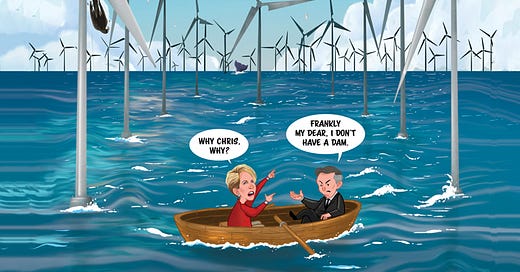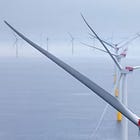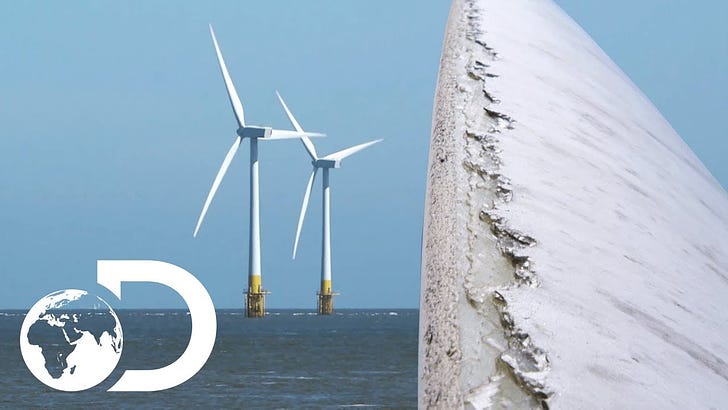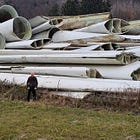"Gone with the wind"
"Offshore wind, it seems, is not a solution to anything but a perfect storm of costs"
This is a great article published by The Spectator Australia for their weekend magazine edition which draws upon the “perfect storm of costs” and increased demand for subsidies by wind developers in the UK.
Gone with the wind
A perfect storm of costs
By Mark Lawson
Cover by Sarah Dudley, illustration by Ben DavisBy Mark Lawson • 15 July 2023 [Magazine]
In the renewable energy industry hope ever springs eternal, with Australia and the US forging ahead with plans to build a host of offshore wind turbines just as the UK is realising its large offshore wind sector is only adding to its power woes.
After years of assurances from renewable energy advocates that the UK’s offshore wind farm sector will deliver cheap and plentiful power, with the equivalent of more than 15 gigawatts of capacity now installed, the country’s power prices are amongst the highest in all Europe.
A major reason for the increase is the price of gas, with wholesale power from gas plants three times more expensive than before the crisis, according to the UK media, but wind power is simply adding to the problem. By some estimates power from the offshore turbines is even more expensive than gas power during the crisis.
The costs of building wind turbines capable of surviving major storms well out to sea are immense and increasing, as are the costs of maintaining generators mounted at the top of 200-metre poles far from land. Despite subsidies and a system for allocating power contracts which greatly favours the industry, UK wind lobby groups have written to the government asking for a vast increase in assistance, including tilting the auction system for power contracts further in their favour.
However, Australia and the US seem determined to repeat all the mistakes of their UK cousins and add a few of their own. In Australia, plans for offshore wind are still in the early stages. A wind farm zone has been designated in the relatively shallow waters off Victoria’s southern coast east of Melbourne which also happens to be within easy range of major transmission lines. Although considerable interest in building 300-metre tall towers (the same height as the Eiffel tower in Paris) has been reported, the project is not expected to deliver power until 2032. Other wind zones are still being discussed.
In the US, the country’s third offshore wind farm was given federal government permission in early July, with several more in the approvals pipeline. However, the latest project, including 100 turbines to be built within sight of the tourist havens of Atlantic City and Ocean City, has generated considerable opposition from community groups objecting to the beach view being spoiled.
All these proposals come with the usual blather about how cheap such power will be, despite the fact that in the UK the cost of the ruling Tory government’s obsession with wind farms is now becoming apparent.
As an example, the UK Telegraph states that the offshore wind farms Hornsea Two and Moray East were completed in 2022 with capital costs of about £2.75 billion ($A5.28 billion) per GW, or more than four times the cost of closed cycle gas turbine capacity. Estimates of maintenance costs, according to the Telegraph, are as high as £200 million per GW installed, per annum. That adds up to a nominal cost of offshore wind generation of £170/MWh, or about the same or somewhat higher than for gas turbines, even in these dire times of high gas prices.
On top of that figure must be added the costs of accommodating the variable output of such turbines. This includes keeping conventional, that is fossil-fuel, capacity on standby to fill the power gap when wind dies. In addition, in the UK, a large, and growing, contribution to these balancing costs involves paying a wind farm not to put power onto the grid when there is an excess, say when it is windy in the middle of the night. (In Australia, wind farms over a certain size are simply required to stay off the grid when directed by power grid managers.)
According to the energy news website Energy Live, in 2022 the UK grid spent more than £4 billion on balancing costs, or many times the costs of balancing the grid in the pre-wind era.
In addition to balancing costs the UK has a contracts for difference system which, details aside, guarantees prices paid to wind farms for power delivered. The subsidies required for this system are raised through a statutory levy on electricity suppliers and ultimately passed onto power consumers.
The wind industry is now saying that despite all that assistance offshore wind farms are not making enough to keep their own lights on. RenewableUK, the country’s trade association for renewable energy, announced in early July that the leading wind energy lobby groups have collectively written to the government saying that various projects are under threat unless they get more money, and the tendering system for contracts is changed.
The letter itself does not seem to be available and the mainstream media have largely ignored the story. But from RenewableUK statements and available commentary, it is apparent the wind industry is saying the budget for fixed-foundation offshore wind alone has to be at least two-and-a-half times higher than its current level. That means the industry has its hand out for more than £165 million.
In addition, the sub-sector of floating wind generators should be given its own budget pot and the auction rules changed. Winners are not determined by lowest bids but by an administrative decision that weights bids according to their ‘value’ in contributing towards the net-zero targets.
To justify all of this the wind industry points to a surge in supply chain costs pushing up the price of wind turbines, while increases in global interest rates have raised refinancing costs substantially. Those cost pressures have pushed several projects into the red just a year after they won government contracts. A widely reported winning bid in that round of contracts was for about £75 per MWh, as opposed to the Guardian newspaper’s estimated cost of £175 per MWh
Then there are the problems at Siemens Energy’s wind turbines division, Siemens Gamesa, which bills itself as a leader in renewable energy, particularly in offshore wind in which it holds 44GW worth of projects.
According to the latest quarterly report for Siemens Energy the division managed to lose £386 million on revenue of £2.44 billion for just the three months to the end of March, with the parent company warning of ‘deeper quality problems’. The quarter’s loss was blamed on inflation, supply chain challenges, the ramp-up of offshore activities and the effects of ‘onerous projects’.
Offshore wind, it seems, is not a solution to anything but a perfect storm of costs which governments in the US and Australia are doing their best to replicate.
Also see these related posts:









